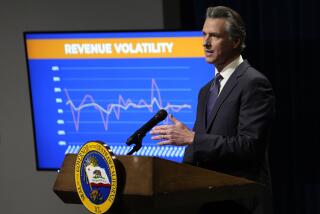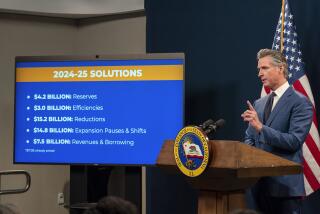Davis Goal: More Stable Tax System
- Share via
SACRAMENTO — When he takes the podium today to deliver his fifth annual State of the State address, Gov. Gray Davis is expected to make a case for basic structural reform of California’s fiscal system -- a tax overhaul, in essence, designed to end a turbulent boom-and-bust cycle that is currently in the depths of a bust.
In recent days he has suggested that he will look for a way to shift the state’s tax burden so revenues are less sensitive to the ups and downs of Wall Street and the wider economy.
Among the options that Davis could consider are such politically volatile proposals as “flattening” the income tax to reduce the burden on the rich, taxing services such as legal counsel and car repairs, and tinkering with one of the state’s most sacred texts: Proposition 13.
“We will not serve the people well if we just find a way to balance the budget without structural reform that prevents this roller-coaster ride from occurring every five to 10 years,” Davis said.
“People expect a certain amount of predictability out of government,” he added, in remarks delivered at a school construction site outside Sacramento. “They’re not going to get it under the current system.”
With such statements, Davis has implicitly acknowledged that the tax system he inherited and accepted for the four years of his first term is deeply flawed and helped create an 18-month budget gap that he now calculates at $34.8 billion, or about one-fourth of the money he had hoped to spend over the next year and a half.
Of course, increased state spending, much of it on Davis’ watch, contributed to the deficit, and the governor is expected to propose deep spending cuts in the budget he will send to the Legislature on Friday.
But much of California’s spending is required by law -- either federal mandates or constitutional ones enacted by California voters, such as Proposition 98, the 1988 measure ensuring that about 40% of the state’s general fund goes to schools.
That means any long-term solution will probably focus on revenue -- in other words, taxes.
Structural Reform
Moreover, many analysts say what is needed is not just increases in tax rates but fundamental changes in the nature of California’s tax system, so-called “structural reform.”
Jean Ross, who heads the nonprofit California Budget Project, said the kind of meaningful structural change Davis is suggesting would require a shift in who carries most of the tax burden, rather than just a change in tax rates.
A significant increase in property taxes or a new tax on services would constitute serious structural change, she said. An across-the-board income tax increase would not.
Any shift in the tax burden is fraught with political peril, since some group will wind up on the losing end. But there are those who say the time is right, given the desperate state of California’s finances.
“Crisis is absolutely essential if you’re going to get any structural reform in California, because the forces of inertia are enormous,” said Bruce Cain, director of UC Berkeley’s Institute for Governmental Studies. “The key to any structural change is that it’s got to happen in the next year and a half.”
More than most states, California relies heavily on a progressive personal income tax, one that puts a large share of the tax burden on the wealthiest Californians. Just under half of the state’s revenues in 2002 came from personal income taxes, well over the national average of 37%.
Moreover, the incomes of the wealthy are tightly tied to the bungee cord of the stock market. When the market freefalls, as it did two years ago, California’s tax base freefalls with it.
The stock market run-up of the late 1990s and early 2000 sent income tax receipts soaring as high-income Californians sold stocks and cashed out stock options. The Wall Street boom pumped billions of dollars in new money into state coffers.
Davis and Democratic lawmakers used the infusion to support higher state spending. But as stock prices dropped, income tax revenues plummeted. The gap between spending and revenues increased rapidly. The resulting budget deficit is a byproduct of the mismatch of revenue and spending.
Davis and his financial advisors have dropped few hints about what the governor might propose in the way of tax changes. There are a number of possibilities.
One of the simplest would be an increase in the top income tax rate from the current 9.3% to the 11% that was in place from 1973 to 1986 and again from 1991 to 1995.
Although attractive to legislative liberals such as Senate leader John Burton (D-San Francisco), that would do little to free the state from the boom-bust cycle and would be anathema to the Republican minority in the Legislature.
The governor could propose leveling the tax rates so that middle-class Californians pay a larger share. But that could draw fire from across the political spectrum.
Davis could propose raising the tax on corporate income. Not only has the corporate tax rate dropped from a high of 9.6% in the late 1970s to 8.84% today, but legislators have enacted tax credits to shield corporations, and accountants have grown more aggressive in designing creative tax shelters.
Still, tax policy specialists doubt that the governor and Legislature will risk giving businesses more economic incentives to leave the state. Davis already has trumpeted job growth as a key policy objective, and chasing business out of California would jeopardize that goal.
Next to personal income taxes, general sales taxes provide the biggest chunk of California’s revenue -- about 30%, a share that has been declining since 1995 as income tax revenue has grown.
Still, a move to raise sales taxes could be politically unpopular, and is considered among the most regressive taxes, with a disproportionate effect on the poor.
One possibility, however, would be a tax on services -- health clubs, movie theaters, auto repair shops, lawyers, doctors, accountants and the like. Economists point out that services have been the fastest-growing segment of the American economy in recent years, but have largely escaped taxation.
“California has a sales tax that reflects the state of the economy in the 1930s,” said Ross of the California Budget Project. “We haven’t bothered to update that tax in the last 70 years.”
The problem is deciding which services to tax. Taxing services that are necessary to the production of consumer goods could be one problem, she said. Taxes on such services as health and child care would inordinately burden the poor. Other taxes could meet opposition from powerful interest groups such as lawyers and the entertainment industry.
“There would certainly be a number of interest groups that would have something to say about this,” Ross said.
One of California’s most powerful interest groups -- property owners -- succeeded in putting a cap on their taxes in 1978 with the passage of Proposition 13. While there is no serious talk of rolling back Proposition 13 to allow higher property taxes for homeowners, there has been discussion of stripping its protection for commercial property owners.
Significantly, the Howard Jarvis Taxpayers Assn., a group established by the original backers of Proposition 13, has taken no position on the idea of allowing reassessments of commercial properties.
Among other taxes, only vehicle license fees have continued to play a significant role in the state budget. Based on the value of a car, these fees reached a peak of $5.7 billion in 1998 before a reduction cut them back by almost a third.
Fiddling with these fees, along with the so-called “sin taxes” on tobacco and alcoholic beverages, would hardly meet the governor’s goal of structural change, but may be among the most politically palatable fixes.
Steven M. Sheffrin, director of the Center for State and Local Taxation at UC Davis, sees vehicle license fees, commercial property taxes and service taxes as the most reasonable sources of new revenue.
Compared to other states, California has “one of the narrower bases of the sales tax,” Sheffrin said. A 1% tax on consumer-level services such as health clubs, movie theaters and auto repairs would raise about $2 billion.
Taxing all commercial real estate at full value would raise about $3 billion, but might require a constitutional amendment, he said.
A vehicle license fee hike seems like one of the easiest fixes, and would add about $4 billion, Sheffrin said.
Sheffrin said the Legislature should consider scrapping dozens of tax breaks that allow credits for everything from child care to solar energy equipment. Combined, these reduce state revenue by almost $8 billion, a California Budget Project report estimates.
*
Times staff writers Michael Finnegan, Mitchell Landsberg and Doug Smith contributed to this report.
More to Read
Get the L.A. Times Politics newsletter
Deeply reported insights into legislation, politics and policy from Sacramento, Washington and beyond. In your inbox twice per week.
You may occasionally receive promotional content from the Los Angeles Times.










